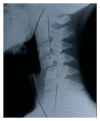Cervical spondylotic myelopathy: pathophysiology, diagnosis, and surgical techniques
- PMID: 22389818
- PMCID: PMC3263543
- DOI: 10.5402/2011/463729
Cervical spondylotic myelopathy: pathophysiology, diagnosis, and surgical techniques
Abstract
Cervical spondylotic myelopathy is a degenerative spinal disease which may lead to significant clinical morbidity. The onset of symptoms is usually insidious, with long periods of fixed disability and episodic worsening events. Regarding the pathophysiology of CSM, the repeated injuries to the spinal cord are caused by both static and dynamic mechanical factors. The combination of these factors affects the spinal cord basically through both direct trauma and ischemia. Regarding the diagnosis, both static and dynamics X-rays, as well as magnetic resonance imaging are important for preoperative evaluation as well as individualizing surgical planning. The choice of the most appropriate technique is affected by patient's clinical condition radiologic findings, as well as surgeon's experience. In opposition to the old belief that patients presenting mild myelopathy should be treated conservatively, there has progressively been amount of evidence indicating that the clinical course of this disease is progressive deterioration and that early surgical intervention improves long-term functional recovery and neurological prognosis.
Figures
Similar articles
-
A review of the pathophysiology of cervical spondylotic myelopathy with insights for potential novel mechanisms drawn from traumatic spinal cord injury.Spine (Phila Pa 1976). 1998 Dec 15;23(24):2730-7. doi: 10.1097/00007632-199812150-00012. Spine (Phila Pa 1976). 1998. PMID: 9879098 Review.
-
Prospective cohort study of mild cervical spondylotic myelopathy without surgical treatment.J Neurosurg Spine. 2012 Jan;16(1):8-14. doi: 10.3171/2011.8.SPINE11395. Epub 2011 Oct 7. J Neurosurg Spine. 2012. PMID: 21981274
-
Cervical canal stenosis due to cervical spondylotic myelopathy C4-C5: A case report.Int J Surg Case Rep. 2019;60:82-86. doi: 10.1016/j.ijscr.2019.05.038. Epub 2019 Jun 4. Int J Surg Case Rep. 2019. PMID: 31207532 Free PMC article.
-
Risk factors for rapid progressive neurological deterioration in patients with cervical spondylotic myelopathy.J Orthop Surg Res. 2021 Jan 21;16(1):75. doi: 10.1186/s13018-021-02227-6. J Orthop Surg Res. 2021. PMID: 33478509 Free PMC article.
-
Cervical Spondylotic Myelopathy: A Guide to Diagnosis and Management.J Am Board Fam Med. 2020 Mar-Apr;33(2):303-313. doi: 10.3122/jabfm.2020.02.190195. J Am Board Fam Med. 2020. PMID: 32179614 Review.
Cited by
-
Comparative outcome analysis of lateral mass fixation and trans-facet fixation with posterior decompression in the management of cervical spondylotic myelopathy: An institutional experience.J Craniovertebr Junction Spine. 2022 Jul-Sep;13(3):357-363. doi: 10.4103/jcvjs.jcvjs_51_22. Epub 2022 Sep 14. J Craniovertebr Junction Spine. 2022. PMID: 36263342 Free PMC article.
-
A summary of assessment tools for patients suffering from cervical spondylotic myelopathy: a systematic review on validity, reliability and responsiveness.Eur Spine J. 2015 Apr;24 Suppl 2:209-28. doi: 10.1007/s00586-013-2935-x. Epub 2013 Sep 5. Eur Spine J. 2015. PMID: 24005994
-
Surgical Treatment of Cervical Spondylotic Myelopathy Associated Hypertension--A Retrospective Study of 309 Patients.PLoS One. 2015 Jul 20;10(7):e0133828. doi: 10.1371/journal.pone.0133828. eCollection 2015. PLoS One. 2015. PMID: 26193469 Free PMC article.
-
Hand Dexterity Impairment in Patients with Cervical Myelopathy: A New Quantitative Assessment Using a Natural Prehension Movement.Behav Neurol. 2018 Jul 4;2018:5138234. doi: 10.1155/2018/5138234. eCollection 2018. Behav Neurol. 2018. PMID: 30073036 Free PMC article.
-
Role of Diffusion Tensor MR Imaging in Degenerative Cervical Spine Disease: a Review of the Literature.Clin Neuroradiol. 2016 Sep;26(3):265-76. doi: 10.1007/s00062-015-0467-y. Epub 2015 Sep 30. Clin Neuroradiol. 2016. PMID: 26423129 Review.
References
-
- Baron EM, Young WF. Cervical spondylotic myelopathy: a brief review of its pathophysiology, clinical course, and diagnosis. Neurosurgery. 2007;60(supplement 1):S35–S41. - PubMed
-
- Brain WR, Northfield D, Wilkinson M. The neurological manifestations of cervical spondylosis. Brain. 1952;75(2):187–225. - PubMed
-
- Furlan JC, Kalsi-Ryan S, Kailaya-Vasan A, Massicotte EM, Fehlings MG. Functional and clinical outcomes following surgical treatment in patients with cervical spondylotic myelopathy: a prospective study of 81 cases. Journal of Neurosurgery. 2011;14(3):348–355. - PubMed
-
- Kumaresan S, Yoganandan N, Pintar FA, et al. Contribution of disc degeneration to osteophyte formation in the cervical spine: a biomechanical inverstigation. Journal of Orthopaedic Research. 2001;19(5):977–984. - PubMed
LinkOut - more resources
Full Text Sources


